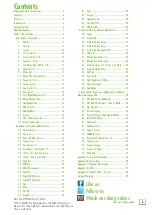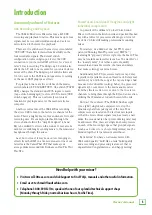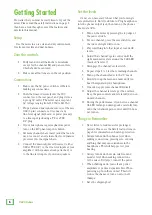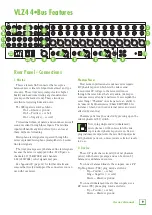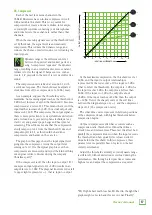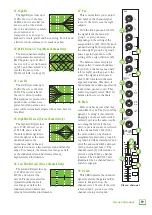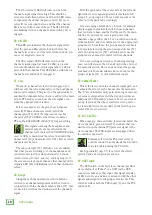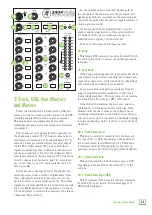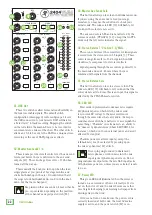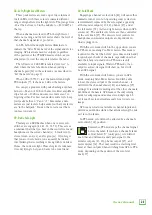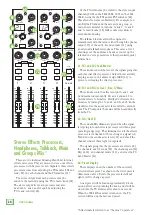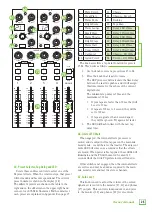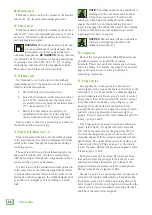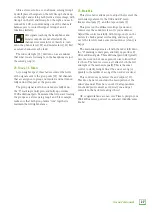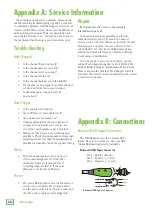
13
Owner’s Manual
The USB routing capabilities are as follows:
USB input TO the mixer – playback:
(1) Stereo channel 23/24 (on the 2404VLZ4) and
31/32 (on the 3204VLZ4) features a USB button, so one
may route computer output (such as iTunes
®
) down the
last stereo channel of the board. This stereo signal may
then be EQ'd, sent to auxiliaries (i.e. to feed monitors,
headphones or effects) and is routable to mains and/or
subgroups via the fader routing features that are
available on all other channels. In short, this signal may
be sent to nearly any desired output or pair of outputs.
Additionally, the gain knob at the top of this channel
strip adjusts the USB input level to the mixer to achieve
an optimal signal level.
(2) The 2-Track Return section features a “flip”
switch, so a “Tape” source (connected via RCA cables,
such as an iPod
®
) or the USB signal from a computer
(playing Windows Media Player
®
files, for example) may
be routed to the main bus. This section also features a
solo button and input level adjustment for fading house
music up and down between bands, at a house of
worship, or any other event where this may be
necessary.
USB output FROM the mixer – recording, etc:
(1) A variety of different signals may be recorded
via the USB output section, depending on the setup. In
the 'USB OUT' section, the switch on the left [51] will
select either Groups 1-2 or the main mix to feed USB
output channels 1-2. The second switch (to the right)
will select either Groups 3-4 or Aux 5-6 to feed USB
output channels 3-4.
For example, with both USB ouput switches in the
default position (up), true 4-track recording may be
accomplished via routing to subgroups 1-4. The USB tap
points for the subgroups are pre-fader (also pre-insert)
and post-compressor. The signals will show up on the
DAW dependent upon how they are panned on the
channels.
In other words, if subgroups 1 and 2 are used to sub
-
mix drums and those drums have a stereo image
(e.g. overheads and toms pan according to desire), this
stereo image is retained in the DAW inputs (assuming
subgroup 1 is set to "L" and subgroup 2 is set to "R").
Any adjustments made to the subgroup drum levels
during the show only pertain to the live show itself;
recording levels are not adjusted in the DAW unless they
are adjusted on the channels. However, compression
settings made on the mixer will apply to the recording.
Likewise, it is possible to record the main mix to take
home a copy of the live show. These levels are also
pre-main fader. Therefore, levels may be mixed up or
down in the DAW later depending on the needs of the
recording versus the live show. The end result is that
fade-ins and/or fade-outs made during the show do not
affect recorded levels.
And finally, it is possible to route the aux 5-6 (again,
pre-fader) mixer signals into a DAW or plug-in host.
From there, re-route the output of the DAW (or plug-in
host) back into the mixer. Voilà...a powerful outboard
effects unit!
Success here is partially dependent upon the
computer's speed. It needs to be fast enough
to run at low buffer sizes so that there is no
noticeable latency between the input signal and, say,
the reverb return. This kind of flexible routing allows
for a variety of choices: running aux 5-6 as effects sends
to outboard gear, internal effects sends (native to the
board), DAW plug-ins (via USB) or as monitor mix
feeds...a truly powerful feature! Be sure to review the
software requirements on www.720trees.com to confirm
that the latest device drivers are currently in use.
POWER
ON
PHANTOM
ON
3
2
1
2
1
2
1
6
5
4
3
2
1
6
5
4
3
2
1
4
SUBGROUP OUTS
BAL / UNBAL
SUBGROUP INSERTS
TIP SEND, RINGRETURN
AUX INSERTS
TIP SEND, RING RETURN
AUX SENDS
BAL / UNBAL
3
2
1
4
L
R
MONO
L
R
MONO
STEREO RETURNS
BAL / UNBAL
21/22
23/24
BAL / UNBAL
BAL / UNBAL
MONITOR
MONO
MONITOR
L
R
100 - 240 V
50 - 60 Hz 55W
TALKBACK
MIC
RIGHT
MAIN OUT
INSERT
LINE
LEFT
MAIN OUT
INSERT
LINE
MONO
MAIN OUT
INSERT
LINE
LEVEL
OUTPUT
L
USB
R
L
R
TAPE
OUT
IN
TIP SEND
RING RETURN
TIP SEND
RING RETURN
TIP SEND
RING RETURN
BAL / UNBAL
BAL / UNBAL
BAL / UNBAL
20
20
20
19
19
19
18
18
18
17
17
17
16
16
16
15
15
15
14
14
14
13
13
13
12
12
12
11
11
11
10
10
10
9
9
9
8
8
8
7
7
7
6
6
6
5
5
5
4
4
4
3
3
3
2
2
2
1
1
1
ONYX MIC PREAMPS
LINE
(BAL / UNBAL)
INSERTS
(TIP SEND, RING RETURN)
L
INE
(BAL / UNBAL)
I
NSERTS
(TIP SEND, RING RETURN)
ONYX MIC PREAMPS
UNBALANCED
REVISION
SERIAL NUMBER
REPLACE WITH THE SAME TYPE FUSE AND RATING.
DISCONNECT SUPPLY CORD BEFORE CHANGING FUSE
UTILISE UN FUSIBLE DE RECHANGE DE MÊME TYPE.
DEBRANCHER AVANT DE REMPLACER LE FUSIBLE
WARNING:
TO REDUCE THE RISK OF FIRE OR ELECTRIC
SHOCK, DO NOT EXPOSE THIS EQUIPMENT TO RAIN OR
MOISTURE. DO NOT REMOVE COVER. NO USER SERVICEABLE
PARTS INSIDE. REFER SERVICING TO QUALIFIED PERSONNEL.
AVIS: RISQUE DE CHOC ELECTRIQUE — NE PAS OUVRIR
THIS DEVICE COMPLIES WITH PART 15 OF THE FCC RULES FOR THE U.S. AND THE ICES-003 FOR CANADA. OPERATION
IS SUBJECT TO THE FOLLOWING TWO CONDITIONS: (1) THIS DEVICE MAY NOT CAUSE HARMFUL INTERFERENCE, AND
(2) THIS DEVICE MUST ACCEPT ANY INTERFERENCE RECEIVED, INCLUDING INTERFERENCE THAT MAY CAUSE
UNDESIRED OPERATION.
+6
U
3
14
20
2
13
1
16
11
17
12
22
7
7
9
18
21
19
4
15
5
10
8
8
8
6



